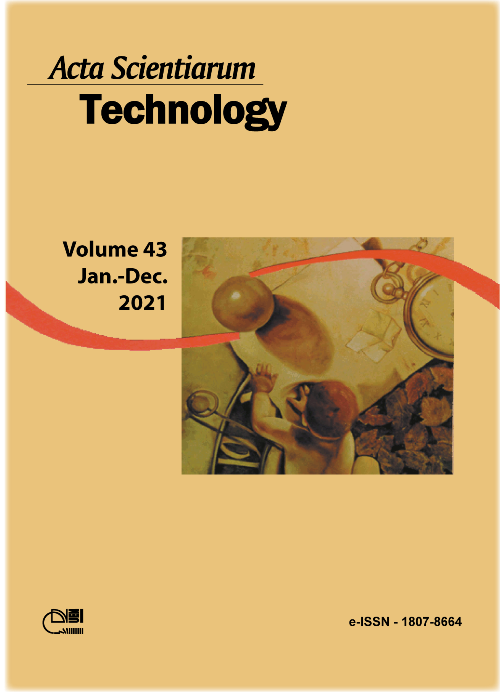Green synthesis: characterization and biological activity of silver nanoparticles using aqueous extracts of plants from the Arecaceae family
DOI:
https://doi.org/10.4025/actascitechnol.v43i1.52011Palavras-chave:
scanning electron microscopy; dynamic light scattering; antimicrobial activity; transmission electron microscopy.Resumo
This study proposes the preparation, characterization, and evaluation of the antimicrobial activity of silver nanoparticles (AgNPs). AgNPs were synthesized from the leaf extracts of plants from the Arecaceae family, which are abundant in the Amazon region. AgNPs were characterized using UV/Vis spectroscopy, Fourier Transform Infrared Spectroscopy (FTIR), dynamic light scattering (DLS), and their minimum inhibitory concentrations (MIC) against the bacteria Escherichia coli and Staphylococcus aureus. AgNPs presented maximum absorbance between 420 and 430 nm, the mean diameter obtained by DLS ranged from 130.43 to 352.93 nm and the polydispersity index (PdI) ranged from 0.523 to 0.689. The surface charge measured by the Zeta potential was negative and ranged from -17.2 to -26.97 mV. FTIR analysis suggests that the phenolic compounds and/or proteins in the chemical composition of the plants studied may have been responsible for the reduction of Ag+ ions and stabilization of AgNPs. The morphology of AgNPs observed was largely spherical and presented some agglomerates. Transmission electron microscopy analyses showed polydispersed AgNPs without the formation of large agglomerates. The synthesized AgNPs presented homogeneity and rapid bioreduction. The concentration of AgNPs required to eliminate microorganisms by up to 90% was lower for Gram-negative bacteria (2.75 μg mL-1) than for Gram-positive bacteria (21.75 μg mL-1). In addition, AgNPs synthesized from plant species that are native to the Amazon proved to be promising, since they showed excellent antimicrobial activity against microorganisms of clinical interest.
Downloads
Downloads
Publicado
Como Citar
Edição
Seção
Licença
DECLARAÇíO DE ORIGINALIDADE E DIREITOS AUTORAIS
Declaro que o presente artigo é original, não tendo sido submetido í publicação em qualquer outro periódico nacional ou internacional, quer seja em parte ou em sua totalidade.
Os direitos autorais pertencem exclusivamente aos autores. Os direitos de licenciamento utilizados pelo periódico é a licença Creative Commons Attribution 4.0 (CC BY 4.0): são permitidos o compartilhamento (cópia e distribuição do material em qualqer meio ou formato) e adaptação (remix, transformação e criação de material a partir do conteúdo assim licenciado para quaisquer fins, inclusive comerciais.
Recomenda-se a leitura desse link para maiores informações sobre o tema: fornecimento de créditos e referências de forma correta, entre outros detalhes cruciais para uso adequado do material licenciado.



















